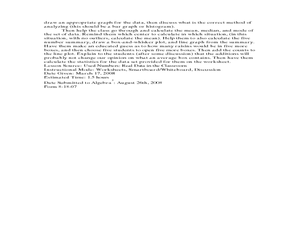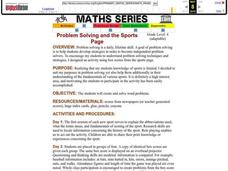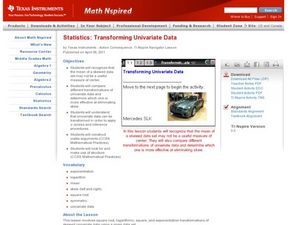Curated OER
Is the Rainbow Fair?
Third graders perform statistical calculations. Given a bag of Skittles, 3rd graders sort and collect data regarding the colors included in their bag. Using spreadsheet software, students create a bar graph of the information collected....
Curated OER
What's Playing Tonight?
Students collect data and visually represent it. They conduct a survey of favorite movies. Using a spreadsheet, students organize the data and create bar and circle graphs. Students answer statistical questions regarding the data.
Curated OER
Probability
Ninth graders engage in a lesson that is about the concept of probability using the context of recording data and predicting outcomes. They collect marbles while recording data and graphing it. The graph is analyzed and ideas are...
Curated OER
Countdown Challenge: Experimental Probability
For this probability worksheet, students compute the experimental probability of an event from given data. They give answers in fraction, decimal and percent form. Students compare the theoretical probability to the experimental...
Curated OER
Countdown Challenge: Probability and You
In this probability worksheet, students explain how probability is a part of everyday life by discussing six different scenarios. Afterwards, they draw a picture of probability in their life. This one-page worksheet contains a total of...
Curated OER
Capture/Recapture
Students use proportions to estimate the size of populations. They describe the data with using a graph or table of the estimate. Students use descriptive statistics to calculate mean, median, and mode. They also compare and contrast an...
Curated OER
Binomial Probabilities: Understanding Math
Although this binomial probabilities worksheet is based on a computer math program (Neufeld Learning Systems: Understanding Math), it can easily be used without the program. If you don't have the program, skip the first question....
Curated OER
Probability Fun
What are the chances? Probability comes into play in this worksheet as mathematicians examine a circular chart with images, determining the possibility that the "spinner" will land on each of the images. Appropriate for younger...
Curated OER
Confidence Intervals: Population Mean; Population Standard Deviation Unknown
In this confidence interval worksheet, students examine given statistical information to find the margin of error. They construct a confidence interval for the population and find the mean. Seven statistical problems are available on...
Curated OER
Confidence Intervals: Population Mean; Population standard Deviation Known
In this confidence interval worksheet, students examine a given confidence level and sample data to determine the margin of error, identify a confidence interval, list the mean and give the standard deviation. Students complete seven...
Curated OER
Confidence Intervals: Population Proportions
In this interval worksheet, young scholars examine given data to construct a confidence interval for a specified proportion. They also identify the minimum sample size needed to support the required margin of error around the population....
Curated OER
Binomial Probability Distribution Section 5.4
In this Binomial Probability Distribution, young scholars use the binomial probability formula to determine the success of a given probability. Using the given parameters, students write a probability equation and solve the problem. They...
Curated OER
Raisin the Statistical Roof
Use a box of raisins to help introduce the concept of data analysis. Learners collect, analyze and display their data using a variety of methods. The included worksheet takes them through a step-by-step analysis process and graphing.
Curated OER
TI-82 PROFICIENCY
Students find the proper factors for numbers one through fifty using either the divisibility laws or TI-82. They determine the sum of the proper factors for each number. If the sum of the factors is less than the number itself, then this...
Curated OER
Using Computer for Statistical Analysis
Students use the computer and S'COOL data for statistical analysis.
Curated OER
The Race of Baseball All-Stars
Collect and analyze data. Pupils graph their data and model with it to solve real life problems. They use logic and deductive reasoning to draw conclusions.
Curated OER
Agricultural Statistician
Students explore how statistics effect their daily lives. They discuss how statistical data is collected for the purposes of agriculture.
Curated OER
Measuring Crime and Fear of Crime
Have your learners delve into the realm of crime statistics using this resource. They use data to answer a series of questions about crime in Britain.
Curated OER
Problem Solving and the Sports Page
The use of box scores from baseball games is the foundation of this math lesson. Organize your class into groups of four, and give identical box scores from a baseball game that was just played. Have them create word problems from the...
Curated OER
Word Problems That Involve the Mean (II)
In this word problem learning exercise, learners examine real world problems. They compute the mean, median, and mode of given problems. This one-page learning exercise contains 5 multi-step problems. Answers are provided.
Curated OER
Measures of Central Tendency
Young scholars analyze data using central tendencies. For this statistics lesson, students collect and analyze data using the mean, median and mode. They create a power point representing the different measures of central tendency.
Curated OER
Measuring Dispersion
Students compute the standard deviation for a given set of data. In this measuring dispersion lesson, students compute the mean, and then the distance from the mean for each data point. They find the standard deviation of the data.
Curated OER
Recipe For Disaster
Learners play an interactive game online to learn ratios. In this statistics lesson, students solve problems in an online game about ratio and relating statistics to the real world. This lesson provides hands on as well as teaching time.
Curated OER
Transforming Univariate Data
Learners analyze plotted data in this statistics lesson. They differentiate between skewed and normal data. They also explore and interconnect exponential growth and decay as it relates to the data.

























